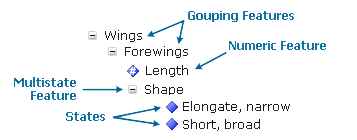Entities in Lucid are the things the key aims to identify. Depending on the scope of the key, the entities may be different kinds of things. For example, in a key to the palms of Brazil, the Entities will be species of palms, in a key to the families of flies of the world the entities will be fly families, in a key to minerals the Entities will be types of minerals, in a key to disorders of sweet potatoes the Entities will be the causes of disorders found in sweet potatoes.
In Lucid we use the term Entity because it applies to all the animals, plants, other organisms, human artifacts, or other possible things that a key may be designed to help identify. Lucid itself doesn’t know whether the Entities are species of plants, families of flies, minerals or diseases – they are all simply Entities to Lucid, and are all handled in the same way.
Specimen Entities are ‘sub’ Entities and used to track individual data associated with the parent Entity. For example, specimen entities can represent real world specimens and track their features, via scoring. This data is then combined to form the data of the parent Entity. Imagine you were studying a new species of plant and wanted to record the details of several specimens. Each would be added as an Entity specimen and if we had a numeric feature for leaf length we could record this data. The leaf length feature values for each specimen would be combined to form the parent entity’s leaf length numeric scoring range.
Features in Lucid are characteristics of the Entities in the key that can be used to describe each Entity.
For example, in a key to minerals one feature may be the types of crystalline form shown by the mineral. Of the minerals in the key, there will be a number of different crystal forms – such as cubic, tetragonal etc. The different possibilities for crystal form are called States of the Feature. States of a Feature are indicated in the Lucid Builder by blue diamonds preceding the State names.
In Lucid there are three main types of features.

Multi-state Features have two or more alternative states.
Numeric Features, by contrast, are ones in which real numbers (integer or decimal) are used to describe the Entities. Numeric Features are normally used for lengths, widths, ratios and counts. For example, a key to butterflies may use a numeric Feature for the length of the forewing, or for the number of segments in the antennae.
Grouping Features are Features that contain other Features. Grouping Features can be converted to numeric Features via the Items property window and vice versa.

